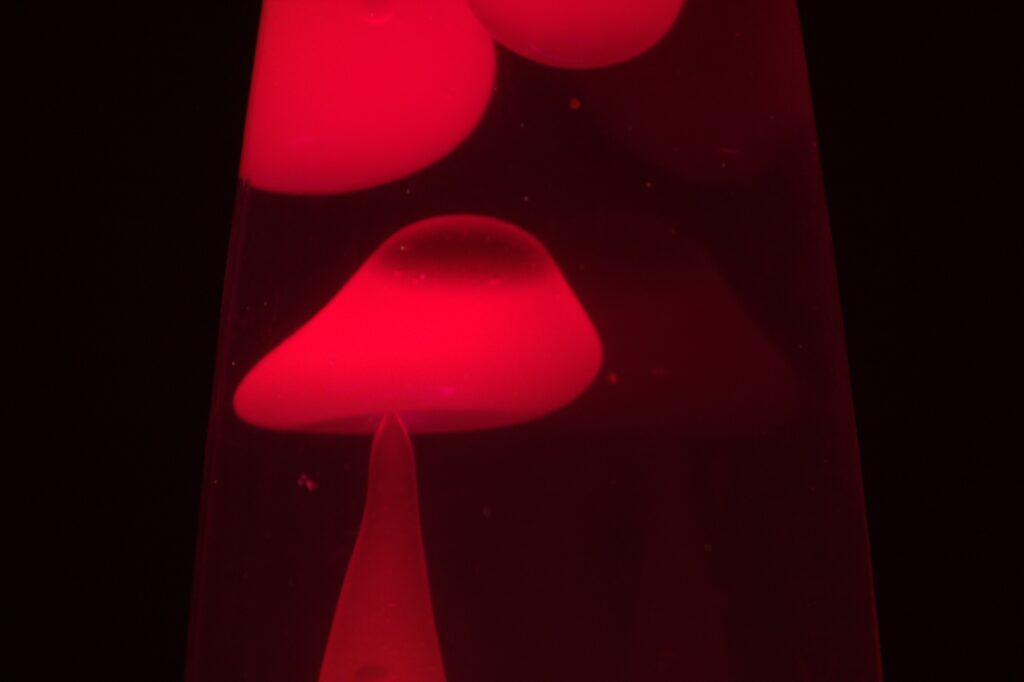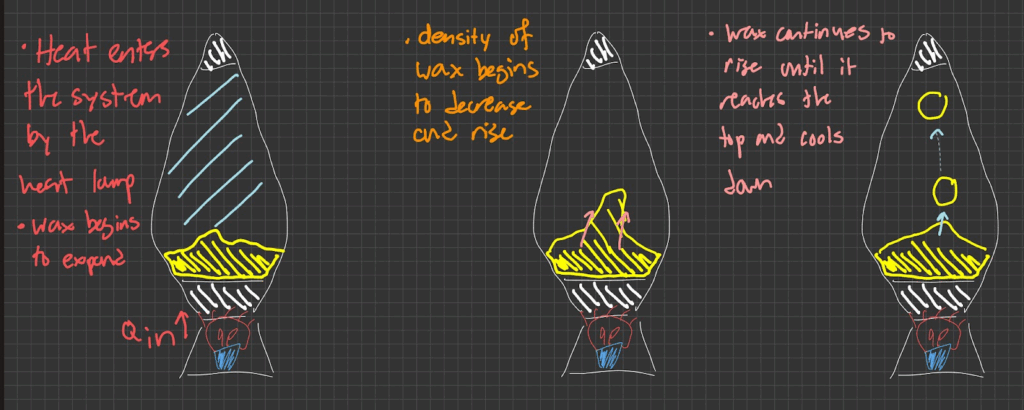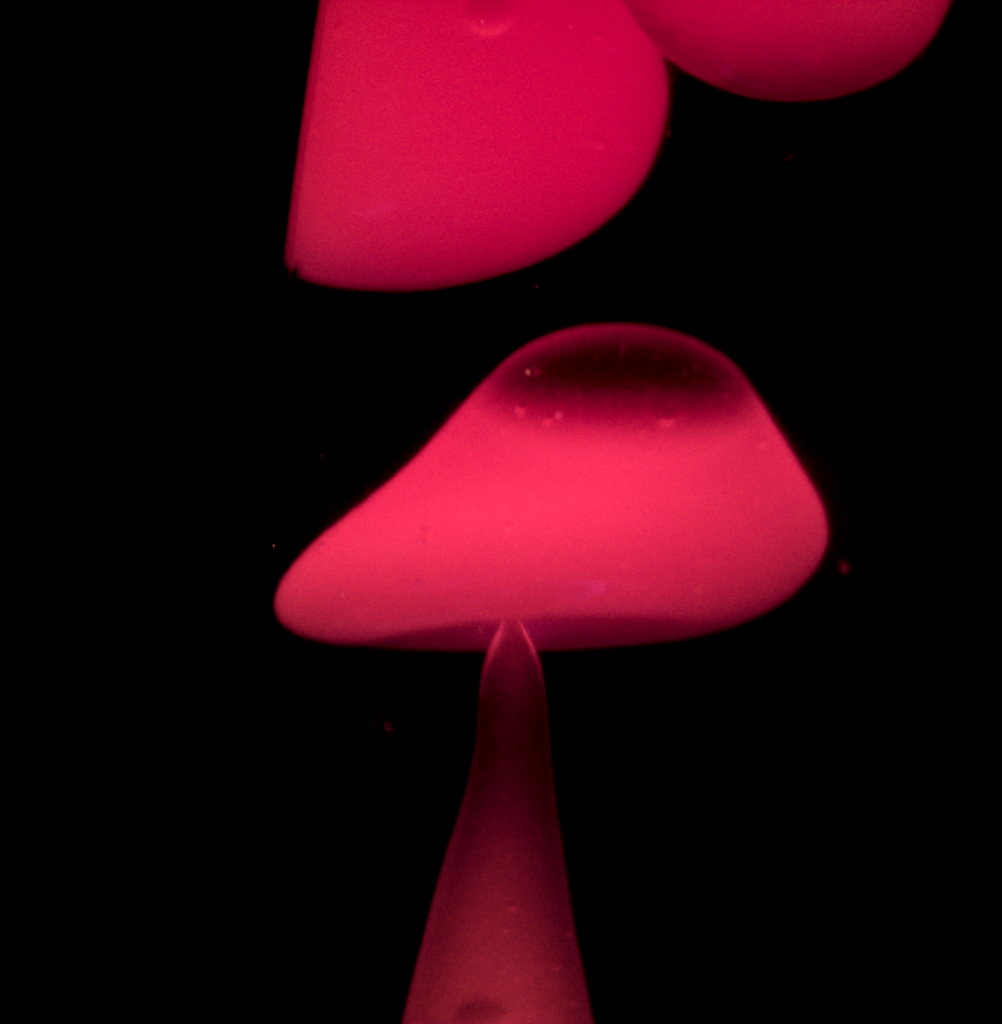Hot wax flowing upward in a lava lamp. Image captures the moment the a segment of wax is separating from the larger wax flow.
Image taken in bathroom with lights off. Photographed by a Canon Rebel T6 with a 18-55m zoom lens. ISO 800, F/5.6, 1/60
Post-processing in darktable; cropped, contrast and tone adjusted
Get Wet Report: Lava Lamp
This is the first project of this course, and was photographed in a dark bathroom as it was the darkest part of the living space. The intent was to capture the way that wax suspended in a solution flows in a lava lamp when heated.
The flow apparatus is a glass tube that contains water, salt, ethylene glycol, dye, and dyed paraffin wax. Placed below the glass tube is a 120V, 30W heat lamp that is supported by a stand. As the wax gains heat from the heat lamp, it begins to expand and become less dense than the surrounding solution. This causes it to become more buoyant than the surrounding solution, forcing the wax to rise through the solution. The “blobs” that form are due to the wax being hydrophobic and repelling the surrounding solution. The wax’s cohesive forces cause it to form semi-spherical shapes, but they are relatively weak and that is why many different shapes form. It is also why the wax breaks up as it rises. The image captures the moment that a longer segment of wax begins to break apart, and the force of the breakage pushes up at the bottom of the blob.
The velocity of the moving wax can be approximated by finding the average images taken per second and estimating the distance traveled between each image. From a similar series of photos with a similar size of wax blob, the average image count was 2.8 images per second. The total distance traveled by the blob on a computer screen was measured and divided by the ratio of the height of the image to the actual glass tube. Then dividing by the number of images between the start and end distance gives us a scaled distance traveled per image. Then multiplying by the images per second gives us the distance per second. Finally, repeating this process for another set of images and taking the average gives us 1.09 inches/second traveled by a blob of similar size to the one photographed. This means it takes approximately 10 seconds for a blob that size to travel the entire distance of the glass tube. This approximation would be improved if a video was taken, and a more precise framerate provided. This approximation makes use of many averages, which will skew the data. Also, the blobs accelerate when they break off from the larger wax formation, as their mass is reduced. So they tend to start out slower, and rise faster at the top.
The visualization technique used is the marked boundary between the wax and the solution. Due to the immiscibility of the two fluids, and the color contrast between the fluids, the flow of the individual wax blobs is highlighted, but the individual flow of each blob cannot be seen. The lighting comes from the heat lamp beneath the glass tube that shines light up through the tube. The light is refracted by the glass and reflects off of the dye in the solution and off of the wax.
The image was captured at a field of view of 1.08 degrees. 7 inches away at 55mm zoom. The camera used to capture the image was a digital Canon DSLR Rebel T6. The original image is 5202×3464 pixels, while the final image is 3550×36464 pixels. The image was shot at 1/60, f/5.6, ISO 800. The image had its local contrast and sigmoid increased to increase visibility of the image.
The image reveals how wax flows upwards through a water-ethylene glycol solution. It shows how blobs of wax break apart, and shows that if the force is great enough, a counter force pushes on the bottom of the wax blob. I enjoy that the image captures the counter force, and I like that the image looks a bit like a mushroom. I also enjoy that the image is monochromatic, and the dark and light portions of the image show depth and shape. The fluid physics are shown well in this image. I question if it would have been better to keep the redness of the original image, as the darkness of the final image may not fully show the flow. I believe I fulfilled my intent to capture the flow in a lava lamp. I would’ve liked the image to be more in focus, and to achieve this I should increase the shutter speed while decreasing the F-stop and ISO. I could also have introduced more light into the image by changing the set-up of the heat lamp.





1 Comment. Leave new
I love the smooth gradients and soft translucence. The flow looks both organic and otherworldly.